We may earn revenue from the products available on this page and participate in affiliate programs. Learn more ›
_
Editors' Pick
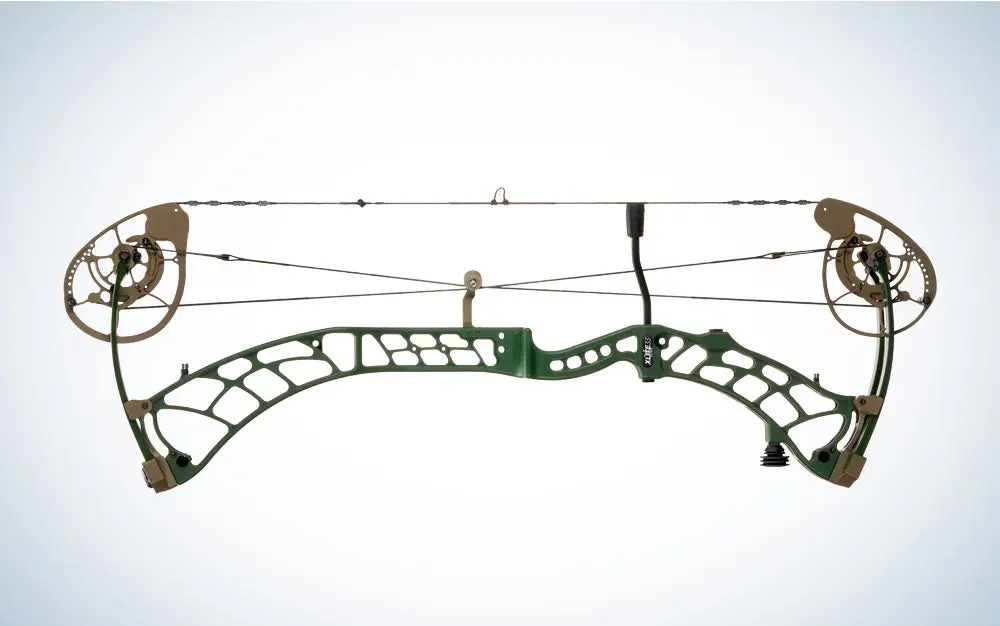
Xpedition Xlite 33
Summary: The Xpedition XLite’s durability, forgiveness and accuracy were unmatched by the competition, making it a unanimous choice for editor’s pick.
Best Speed Bow
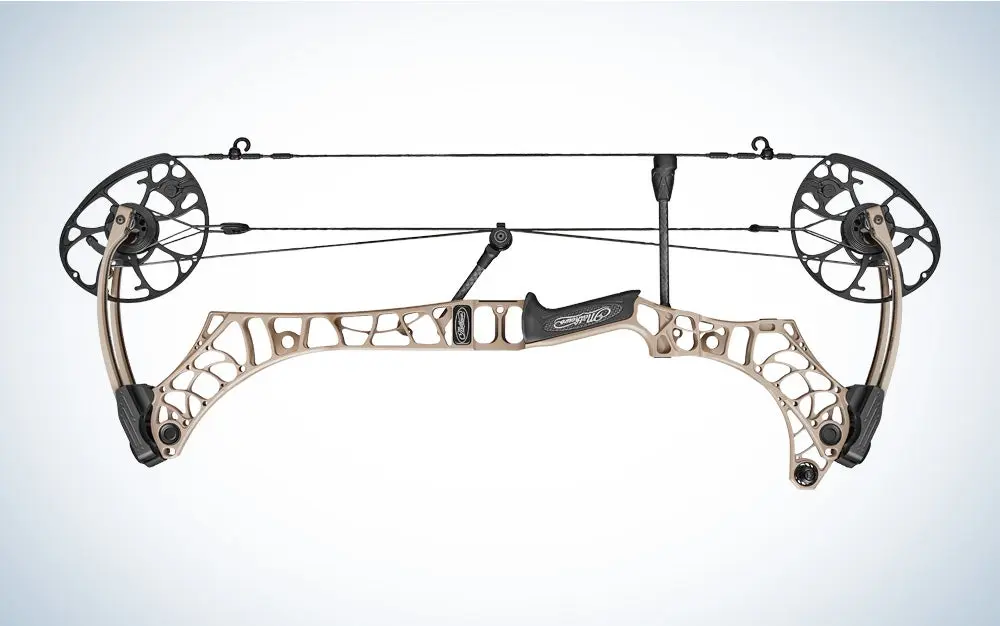
Mathews Phase 4
Summary: At a blistering 318 fps, the Mathews is fast and versatile thanks to the S.A.S. field bow press system for in-the-field repairs while the hunt is still in progress.
Best Draw Cycle

Bowtech SS34
Summary: The Bowtech offers a ton of versatility, most notably in the FlipDisc system allows for a customizable experience between comfort and pure performance.
From first place to dead last, the latest crop of flagship bows is the best I’ve seen in a decade of testing compound bows for Field & Stream. It used to be fairly easy to separate the best bows from the rest, simply with objective measurements like speed, accuracy, and noise. But today’s big players in the compound bow world have hit a performance plateau with their flagships. The top-of-the-line bows for 2023 are all so fast, efficient, quiet, and easy to shoot that on paper, the differences between them are negligible. You’ll see that reflected in this year’s scores and results.
For that very reason, many brands are now working to separate themselves by pouring focus into outstanding accessory systems that complement proven designs or tuning systems that make DIY bow work at home easier. Still, when you get the chance to shoot all of 2023’s new bows side-by-side, as we do—thousands of arrows over the course of several days—you notice subtleties in performance that reveal which are truly the best compound bows of the year.
In the past, our test panel has discussed those things in the open as the test went on. This year, we updated our procedure with a gag order. Nothing was said (aside from the usual smack-talking) about any of the bows until everyone had completed their individual reviews. Only then did we discuss. And when we did, two thing were unanimous: first, that we had a hell of a crop of bows this year, and, second, that one model in particular was the clear winner for overall best new compound bow of 2023.
Editors’ Pick: Xpedition XLite 33
Quietest Bow: Hoyt VTM 34
Best Draw Cycle: Bowtech SS34
Best Speed Bow: Mathews Phase 4
Best Value Flagship Bow: Elite Omnia
How We Test for the Best Compound Bows

The F&S test-panel shooters on the range, evaluating accuracy and forgiveness. Forrest Binkley
Our bow test is an invitational. If you don’t see your favorite brand represented, chances are they declined our invitation to participate. Though some of our scoring procedures and test methods have changed a bit in the past decade, our commitment to a fair and honest review hasn’t. If you’re about to fork over $1,500 or more for a new compound bow and accessories, we see it as our job to bring you a critique that’s unbiased and laser-focused on one simple question: What are the best compound bows for 2023?
The F&S Bow Test Panel
To get that answer, we enlist expert help. Collectively, this year’s three-man test panel has more than a century of bowhunting experience and has taken an estimated 400 big-game animals with archery equipment. We’ve all shot some competition, too, and one of our panel members ran a pro shop for years. Here are our testers.

| The F&S test panel from left: Will Brantley, Danny Hinton, and Keith Meador. Forrest Binkley |
Will Brantley: I’m Field & Stream’s hunting editor and captain of the test. I’ve been bowhunting whitetails for 26 seasons, and have also chased mule deer, elk, antelope, alligators, and hogs with archery tackle. I’ve also taken a wild turkey Grand Slam with a bow. I’m a licensed Kentucky outfitter and spend 50-plus days in a tree stand myself every fall. I love bowfishing in the off-season, and have shot some 3D competition too.
Danny Hinton: Hinton has been on the test panel for a decade and is the perfect blend of former pro-shop owner, engineer, and outspoken hunter who arrows a pile of deer every fall (including a near-Booner last season). Hinton has been bowhunting for 34 years, and has shot his share of indoor 5-spot and outdoor 3D competition, too. He can set up and tune a new bow out of the box faster than anyone I’ve ever met.
Keith Meador: Meador was this year’s test-panel rookie, but he has the most archery experience of any of us. He’s been a bowhunter and competition shooter for 49 years and was formerly ranked among the top five 3D archers in the world. Meador retired from competition archery in 2007, and now hunts most days of the Kentucky archery season.
Stress Engineering: The staff at Stress Engineering in Mason, Ohio, has been assisting us for years with objectively testing compound bows for noise and vibration, which requires specialized equipment and professional engineers who can analyze the data. Their equipment, analysis, and expertise solidify our objective data.
Best Compound Bow Test: Parameters and Set-Up

| Danny Hinton sets up one of the bows for testing. Forrest Binkley |
When we received the test bows, the first thing we did was set them all up with the equipment and to the specs listed below to make sure the playing field is as level as possible. Here’s a rundown:
Right-handed
28-inch draw length
60-pound draw weight
HHA Tetra RYZ sights
1/16-aperture peep sights
D-loop
Drop-away rests (for accuracy testing)
Whisker Biscuit rests (for sound and vibration testing)
28-inch Carbon Express 350-spine D-Stroyer SD arrows / 100-grain field points / 437-grain finished weight
IBO-spec, 300-grain bare shaft arrows (for speed testing)
Test panel members shot scored groups with their personal release aids, but a variety of back-tension releases were also used for additional subjective evaluations of draw cycle and handling
Best Compound Bow Test: Procedure and Scoring
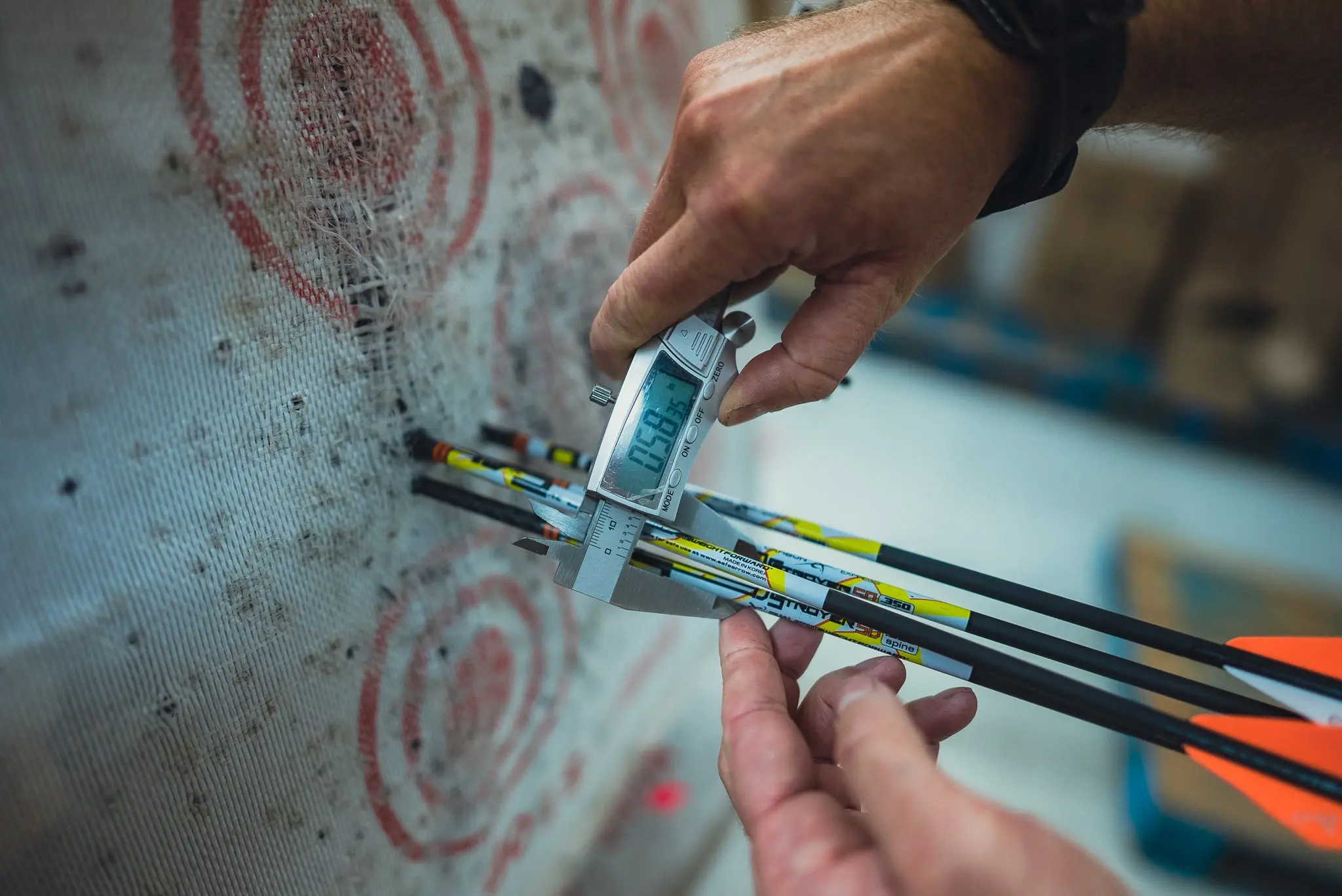
| Will Brantley used a caliper to measure a group on the range. Forrest Binkley |
After setting up the bows, verifying specs, and paper tuning, we weighed each bow with a digital trigger scale to simulate the weight of an actual hunting setup (as opposed to bare-bow weight). Next, each test-panel member hit the 25-yard indoor range, sighted in each bow individually, and then shot five measured, five-arrow groups per bow. Panel members rotated bows between groups to minimize the effects of fatigue. Group sizes for each bow were averaged for each tester, and then collectively averaged at the end of the test. Along the way, testers evaluated every bow for draw cycle, handling, grip, balance, and fit and finish, then made notes on which bows seemed loudest or quietest, or seemed to vibrate the most or least. Those notes were later compared to the measured results we got from Stress Engineering.
With that portion of the test complete, we took the bows to my farm for a series of real-world hunting tests that included broadhead grouping with fixed-blade Muzzy One broadheads; 30- and 40-yard range evaluations; and tree stand shooting from both standing and shooting positions. These tests weren’t scored categories, but they further influenced our subjective scores, like handling and draw cycle. We also evaluated features unique to each compound bow, including accessory packages and tuning systems.
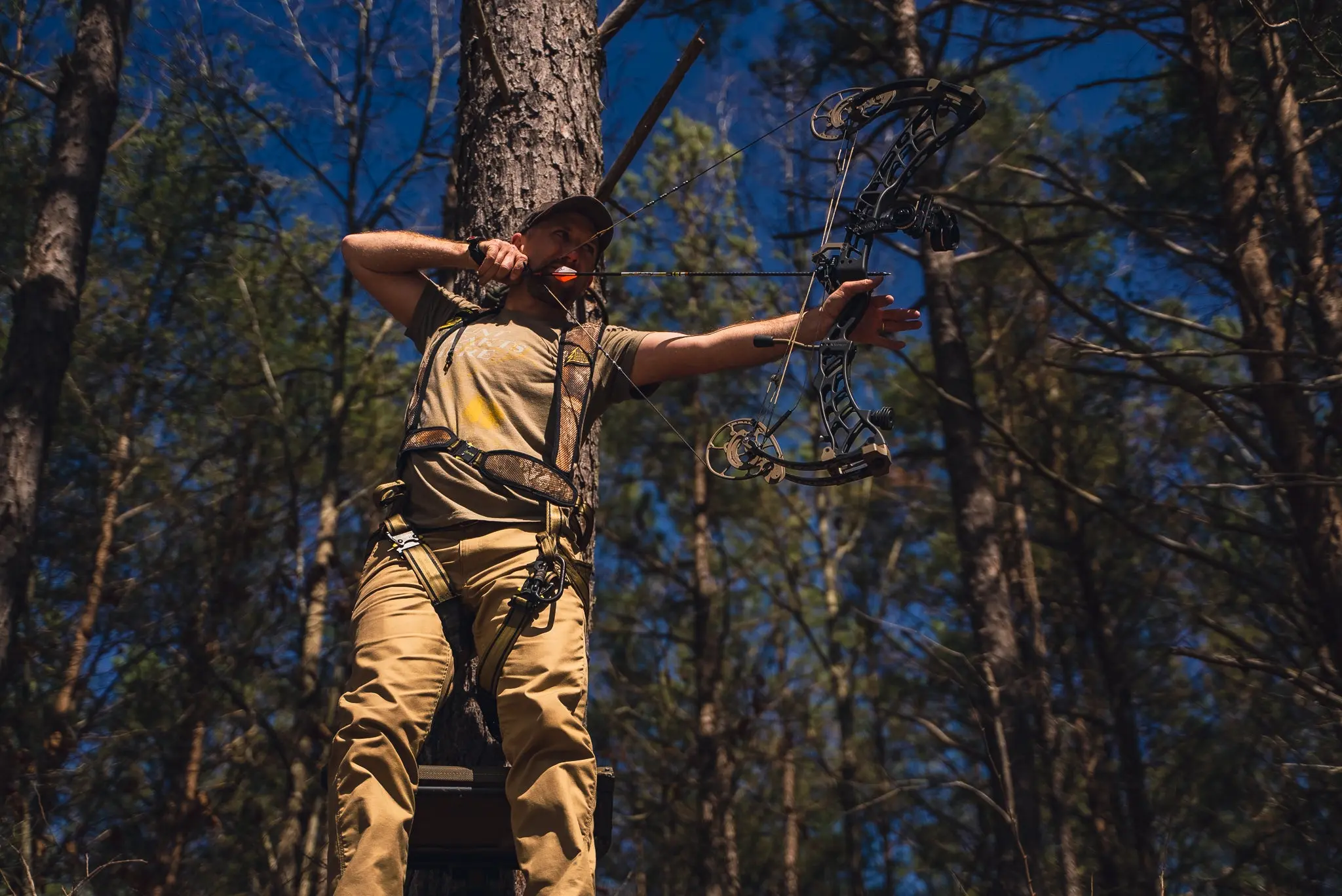
| The author shoots the Xpedition XLite 33 from a ladder stand. Forrest Binkley |
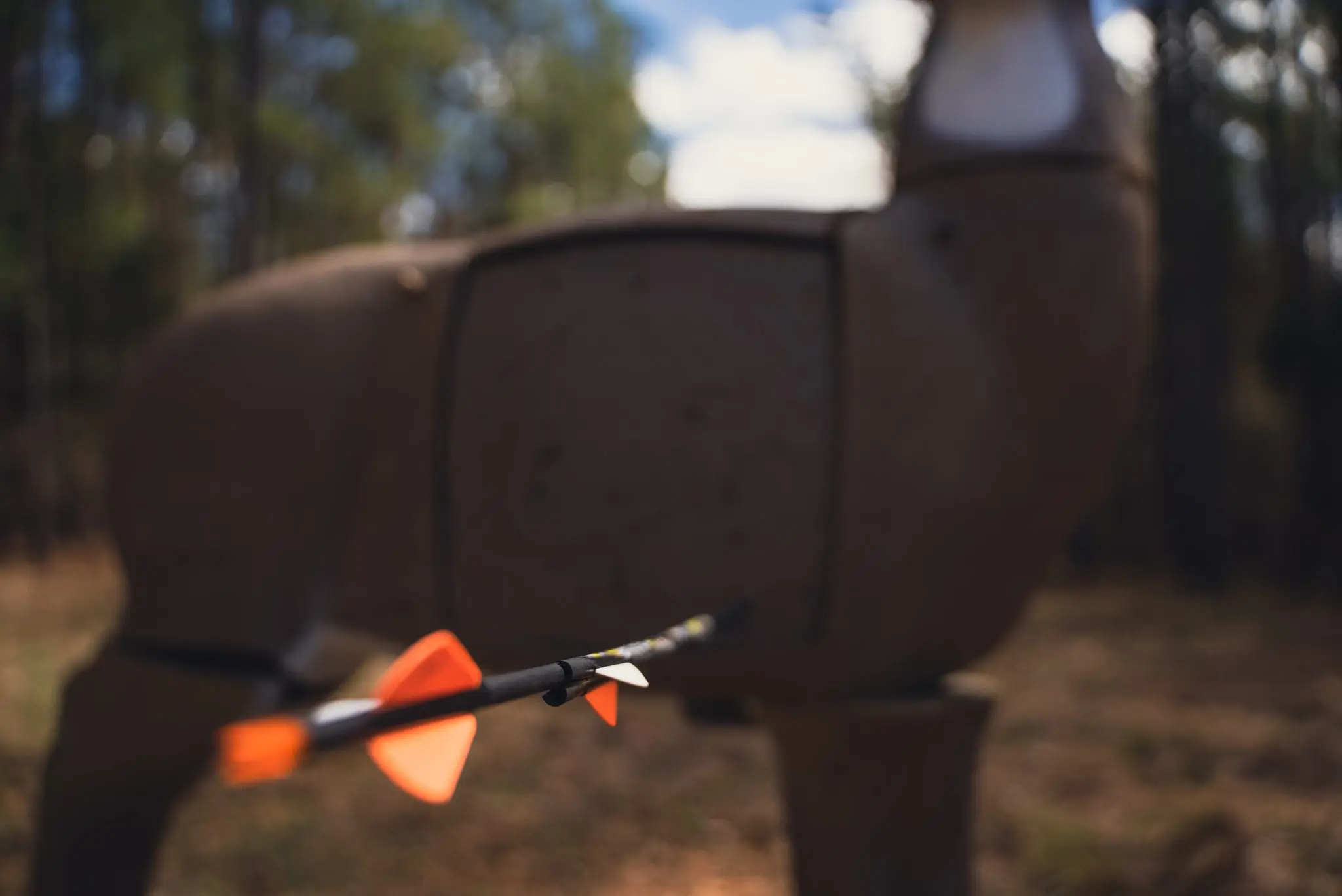
| A Robin Hood on the field-test range. Forrest Binkley |
At the end of the field-testing evaluations, we stripped the peeps, sights, and drop-away rests from each bow, fitted them with Whisker Biscuits, and retuned them. Then I trucked all the bows seven hours north to Mason, Ohio, where I met with Stress Engineering’s Mike Landgraf, who set up a quiet-on-set workstation inside a shop building. Bows were placed into a Hooter Shooter with an accelerometer threaded into the stabilizer port to measure vibration, and a microphone placed on a stand 36 inches from the bow to measure noise. The floor underneath and around the setup was covered with acoustic foam to minimize sound deflection. Each bow was then fired three times to obtain a reliable data sample.
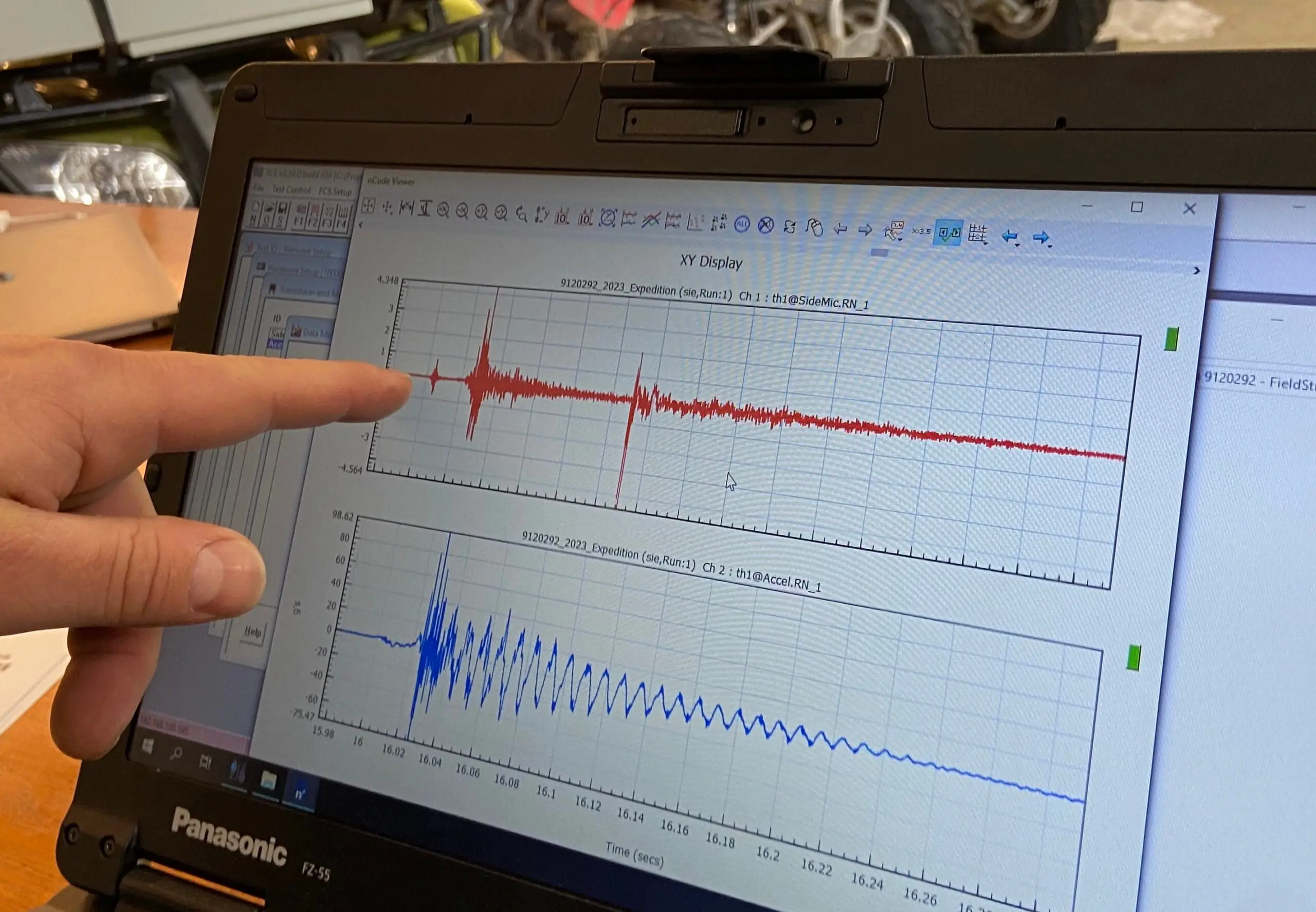
| A Stress engineer evaluates vibration data from an accelerometer attached to a test bow. Forrest Binkley |
Vibration was measured via acceleration immediately below the grip and weighted to the human hand/arm sensitivity range. Noise was measured in decibels by the sound pressure impulse and the sound peak impulse, and those two numbers were then averaged to determine a sound score (this year, all the bows were almost equally quiet). We used the same Carbon Express arrows for sound and vibration testing that we used for accuracy testing because they’re representative of a real-world hunting arrow and of what a live critter is likely to hear.
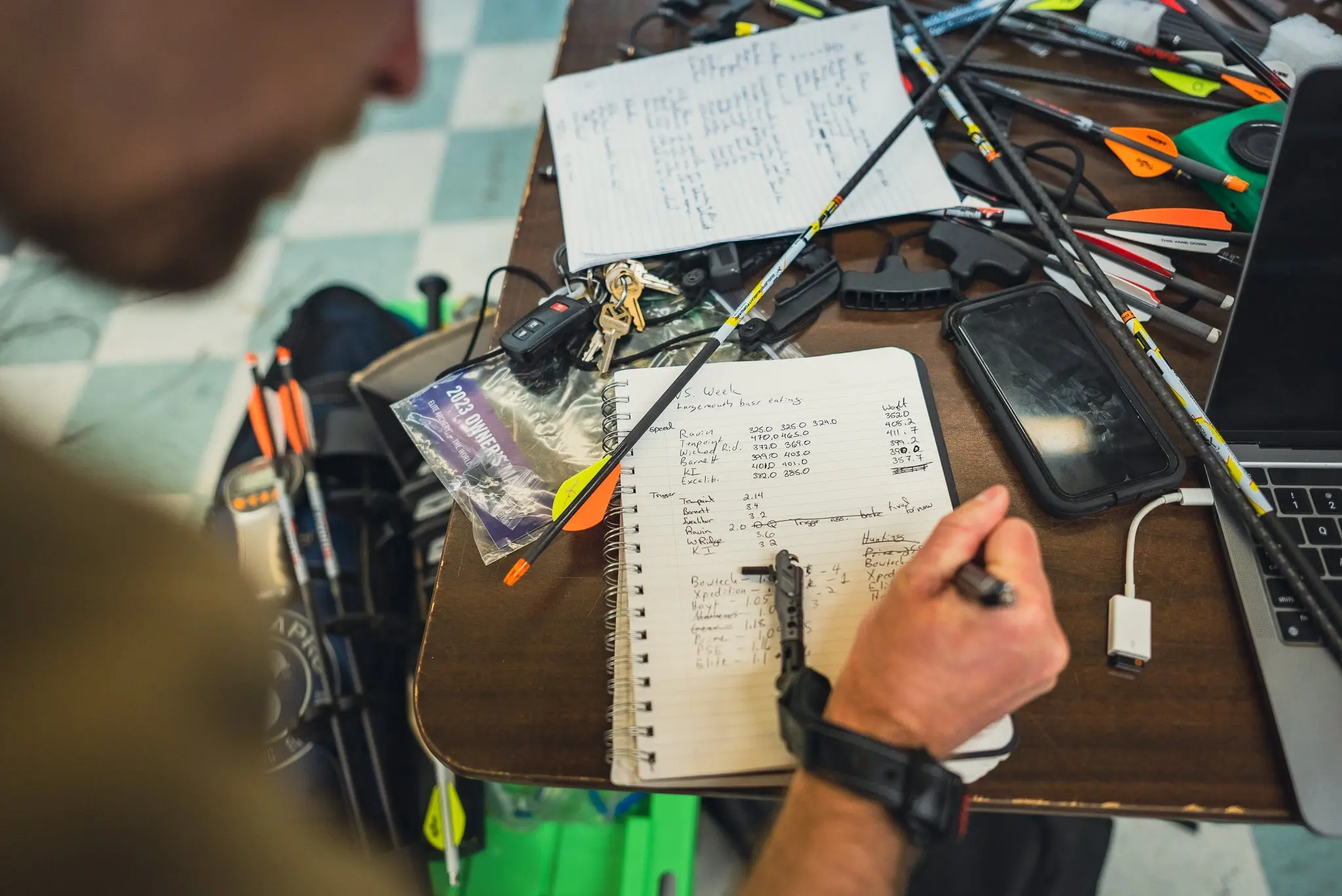
| Brantley jots down notes and scores for the test bows. Forrest Binkley |
Once we had those results, we scored each bow on a 100-point scale in the following categories to determine the best compound bows of the year:
Accuracy and forgiveness (20 points)
Speed (20 points)
Draw cycle (20 points)
Balance, handling, and grip (10 points)
Lack of Noise (10 points)
Lack of Vibration (10 points)
Fit and finish (10 points)
Here is how each bow fared.
The Best Compound Bows of 2023: Reviews and Recommendations
Editors’ Pick: Xpedition XLite 33
Editors' Pick

Specs
Axle-to-Axle Length: 33″
Brace Height: 6.5″
Weight: 5 lb., 4 oz.
Price: $1,999
Testing Results
Speed: 292 fps
Final Score: 96
When our testing was finally over, and we were free to discuss the bows, someone said “Okay, which one is your favorite?” And all three of us picked the XLite 33. The bow’s riser is made from a proprietary alloy called Magnite, which Xpedition says is 33 percent stronger than aluminum and even stronger than commercial-grade carbon. The material is comfortable in the hand, and the bow is at once extremely lightweight without seeming wispy. In addition, the cams and some hardware (like the cable guard and limb pockets) are Cerakoted. We all thought it looked sharp, and the finish should make the bow virtually impervious to the weather.
The XLite was a top shooter for everyone on the test panel, and it was the only bow in the entire field to produce sub-1-inch average groups. It shot broadheads right alongside field points without any additional tuning or sight adjustment required, and it was a joy to handle and wield from a tree stand, as well as to shoot from longer distances. (I Robin-Hooded a pair of arrows at 40 yards with it.) In a decade of testing flagship bows, I’ve never seen one that stood out more in the category of accuracy and forgiveness for everyone on the test panel.
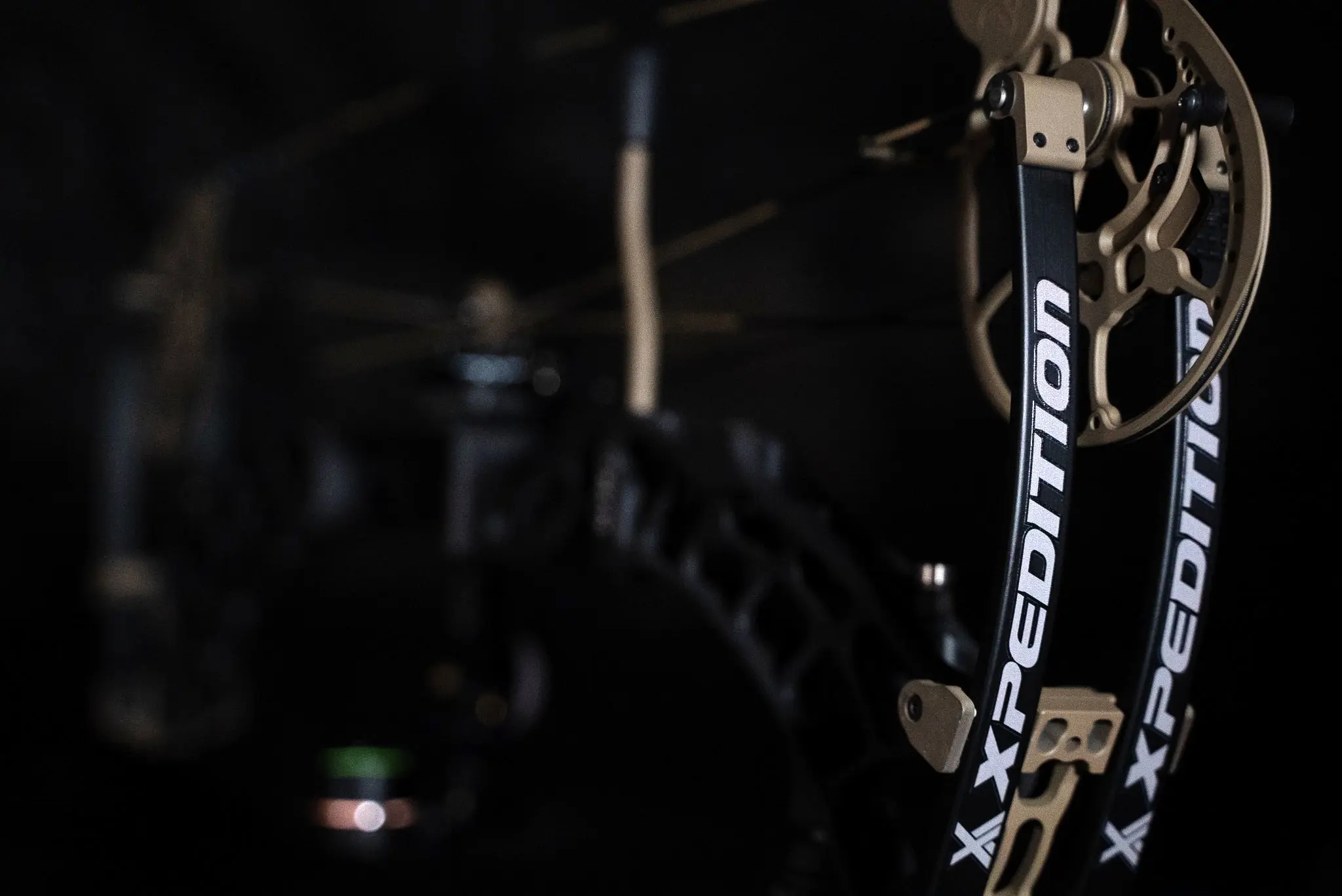
| Forrest Binkley |
But that’s not all the XLite had going for it. As noted, the draw cycles on this year’s bows were smooth almost across the board. But a couple—this one and the Bowtech SS34—were standouts that received perfect, 20-point scores. The XLite uses Xpedition’s new XB1 dual-cam system, which is draw-length adjustable by way of modules.
As for noise, the bow was as quiet as everything else (except for the Hoyt), and it finished middle of the pack for vibration. We deducted some points there. It is worth noting that the Xpedition was the slowest bow in this year’s lineup—and this is one of the very few times in the history of our test that the slowest bow has won the Editor’s Pick Award. That happened partly because there wasn’t a big difference in speeds among the bows this year, outside of the two fastest; so even though it’s the slowest, this bow isn’t terribly slow at 292. But it happened mostly because the XLite 33 got perfect scores in every other category except noise and vibration (where it lost just one point each). Bottom line: When we added up the scores, the XLite 33 came out on top. The fact that it was our unanimous favorite before any numbers were crunched says a lot, too. Put it all together, and you are looking at the best compound bow of the year and the winner F&S’s 2023 Editors’ Pick Award.
Quietest Bow: Hoyt VTM 34
Quietest Bow
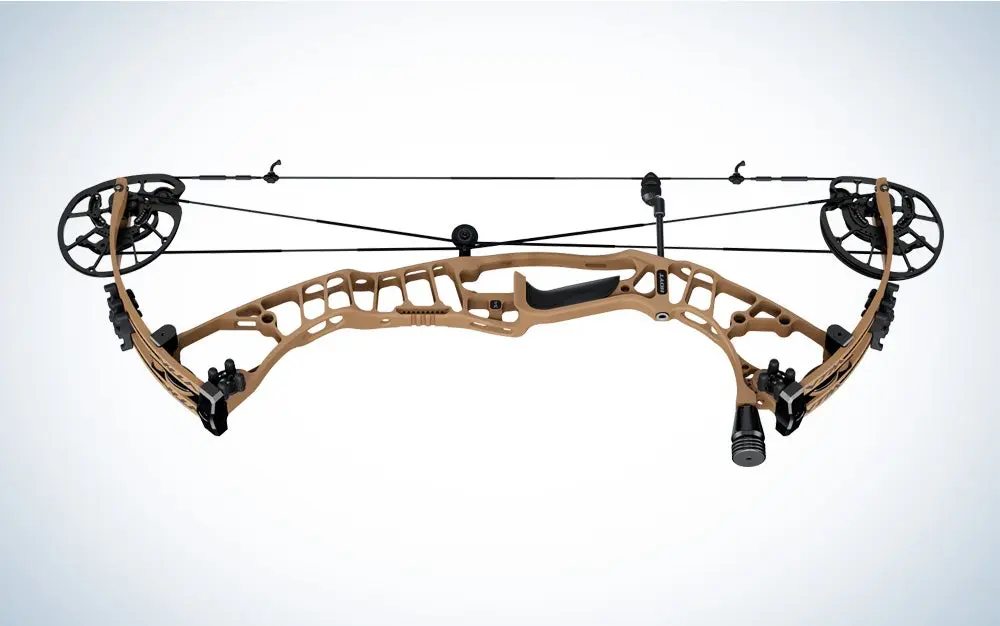
Specs
Axle-to-Axle Length: 33-3/4″
Brace Height: 6.25″
Weight: 6 lb., 2 oz.
Price: $1,499
Testing Results
Speed: 305.3 fps
Final Score: 95
Hoyt’s Carbon RX-7 won our test for best compound bow last year, and this year’s aluminum VTM 34 nearly pulled off a repeat finish. Like its predecessor, the VTM features Hoyt’s binary HBX Pro cam system, which is the best binary system going right now, as far as I’m concerned. The bow was tied with the Prime Revex as the third-fastest of the test, but the VTM scored better for draw cycle—in fact, only the winner and the Bowtech SS34 were smoother. Though noise differences were virtually a wash in this year’s test (all the bows were very quiet), the VTM 34 was nonetheless a full decibel quieter than anything else we tested, according to Stress Engineering measurements, and it had the second-least amount of vibration.
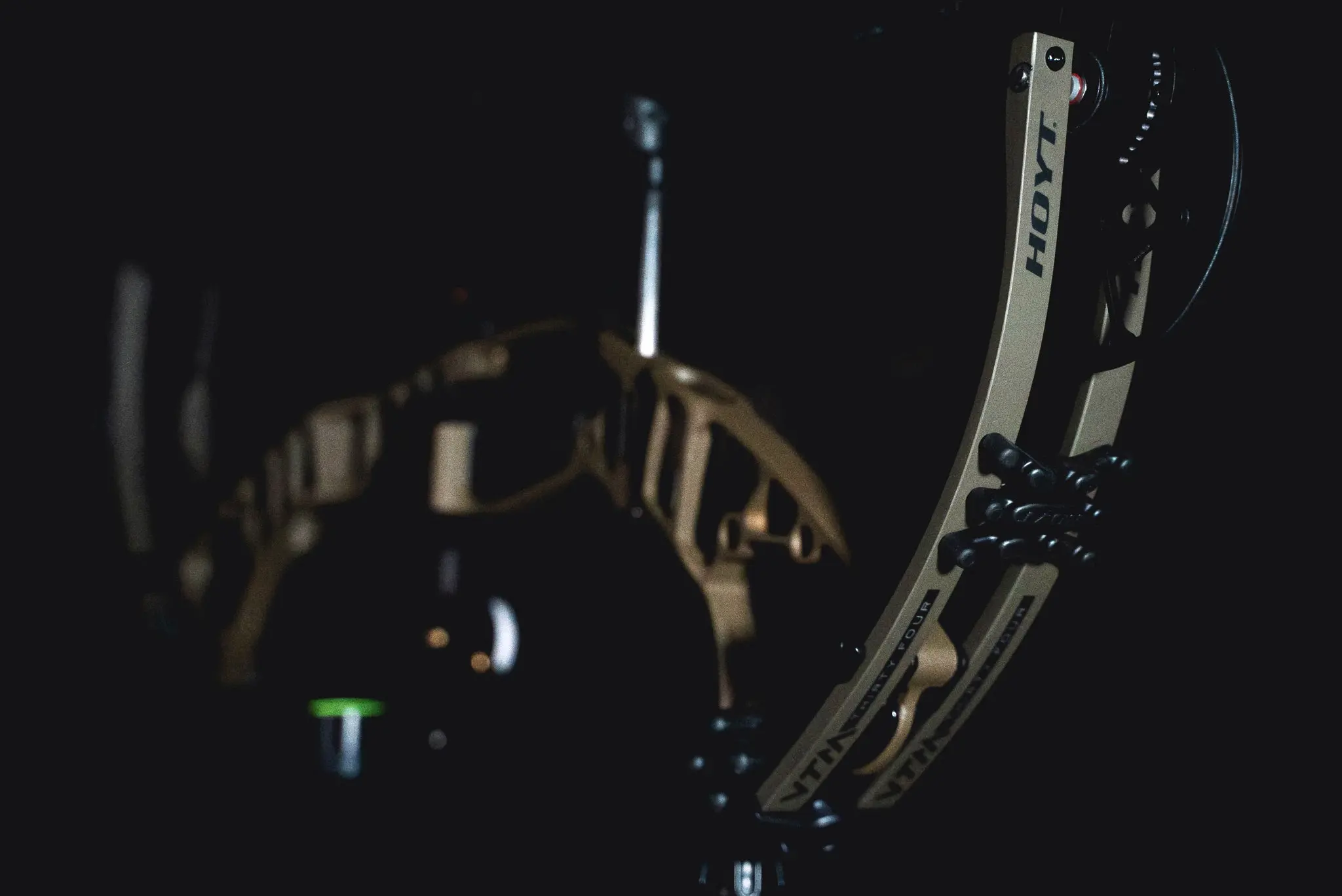
| Forrest Binkley |
It shot extremely well, and was tied with the Mathews Phase 4 as the second-most accurate bow of the test. And, like the Phase 4, the Hoyt VTM series is complemented by an outstanding In-Line accessory system that includes dovetail mounts on the riser for both sights and rests, low-profile quivers, bow stands, and sidebar mounts.
Really, our only complaint about the VTM 34 was its physical size. Like the Bowtech SS34, the VTM 34 is just about 34 inches axle to axle—and those big cams make it longer yet from one end to the other. Add to that a rigid, heavy riser, and bow-arm fatigue sets in fast with the VTM 34 at full draw (noticeably more so than with even the Bowtech, even though the Hoyt was just one ounce heavier). We deducted handling points for that (but keep in mind that a 31-inch version of the VTM, with a slightly shorter brace height, is also available). It’s worth noting the VTM 34, although not cheap by any means, is still $500 less than the only bow that beat it, and it comes with better accessory options to boot.
Best Draw Cycle: Bowtech SS34
Best Draw Cycle

Specs
Axle-to-Axle Length: 34″
Brace Height: 6.75″
Weight: 6 lb., 1 oz.
Price: $1,299
Testing Results
Speed: 297 fps (tested in Comfort mode)
Final Score: 94
The Bowtech SS34 was one of just two bows in this year’s test to get a perfect 20-point draw-cycle score—and this was in a year when we had a bunch of smooth bows. The SS34’s cycle was smooth throughout with a solid back wall, but also without the “slop” sometimes felt with ultra-smooth, high-let-off bows. It was quiet, and vibration was virtually non-existent; only the Hoyt VTM had less.
Like Bowtechs of the past several years, the SS34 features the FlipDisc system that allows shooters to set the bow into a “Comfort” or “Performance” mode, the latter of which produces more speed, but with a more demanding draw cycle and slightly less let-off. As the SS34 is designed and marketed for a smooth-shooting experience, we tested the bow in the Comfort setting. The SS34 also features the DeadLock Cam system, which allows users to tweak cam lean and string alignment by easily adjusting the cam’s system along the axle with the turn of a screw. Truthfully the system hasn’t been my favorite in the past, but I made a point of messing with it more on the SS34, particularly once we started shooting it at longer distances and with broadheads, and I warmed up to it. Like most of this year’s top flagships, the SS34 has a dovetailed riser for accepting rests like the QAD Integrate.
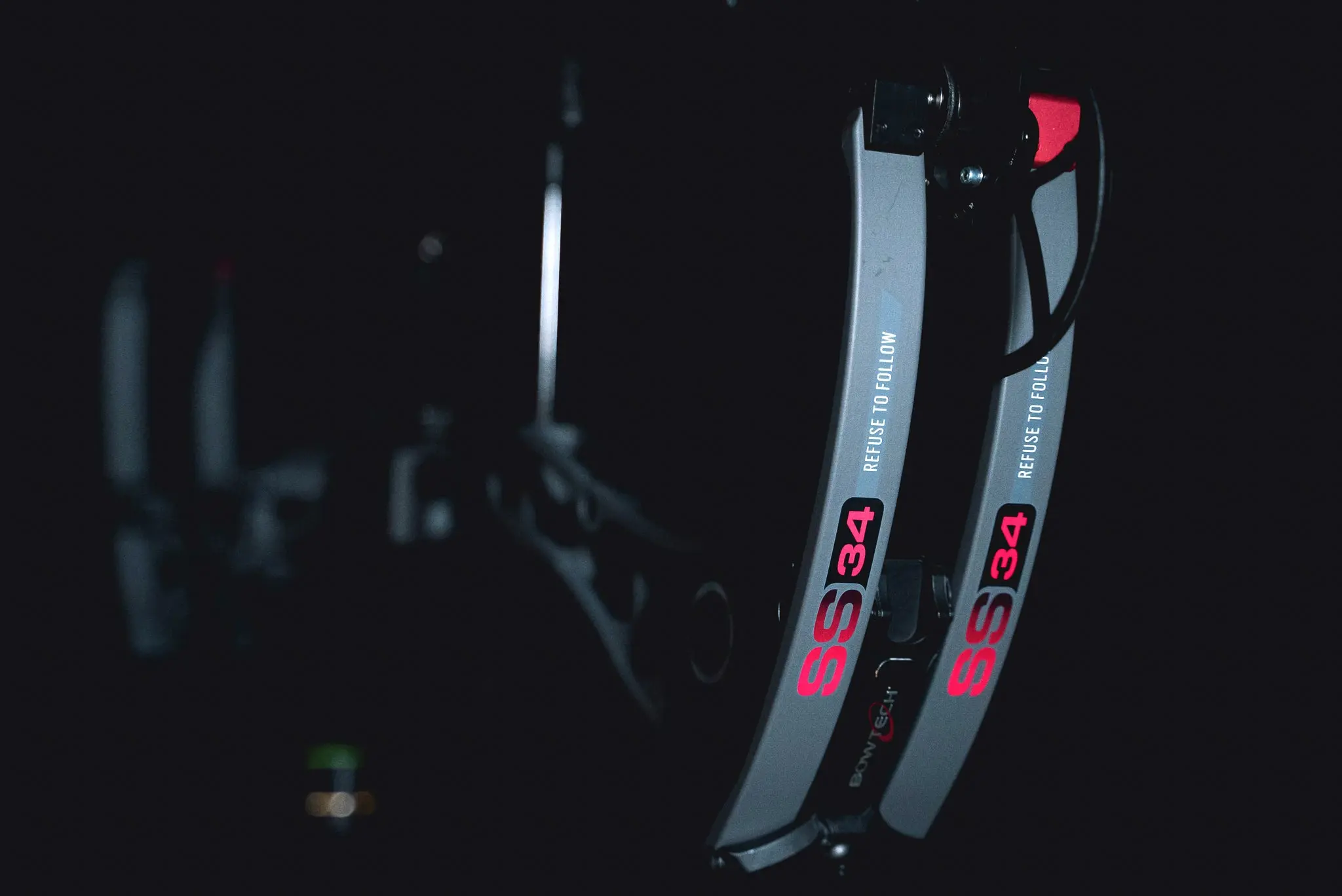
| Forrest Binkley |
The SS34 missed the top spot by only a few points because of small deductions for speed (it was the second-slowest bow of the test) and in accuracy/forgiveness. Everyone shot this bow pretty well, but not exceptionally so, and as a result, it finished middle of the pack in that category. We deducted only a single a point for handling because although the SS34 was a bit heavier and bulkier than any of us would like for a tree stand, it balanced well and features a grip positioning that Meador called “outstanding.” Overall, the SS34 is an excellent bow, and it was hard to fault it for much of anything. If a smooth draw cycle is your first priority, then this may be the best compound bow of the year for you.
Best Speed Bow: Mathews Phase 4
Best Speed Bow

Specs
Axle-to-Axle Length: 29″
Brace Height: 6″
Weight: 5 lb., 11 oz.
Price: $1,299
Testing Results
Speed: 318 fps
Final Score: 94
Mathews’ CrossCentric Cam series of bows have been the winningest flagships on the market since the first Halon 5 won our test in 2016. The most recent models, including last year’s V3X, have been noted for across-the-board excellence, and particularly revered for being quiet and dead-in-the-hand at the shot. The Phase 4 features the same cam system and near identical performance, but an innovative upgrade to the limbs. Look carefully and you’ll notice that there are actually eight of them—four on top and four on bottom, each sandwiching vibration-dampening material in between. Mathews calls it the Resistance Phase Damping system, and it’s designed to settle excess energy directly in the limbs.
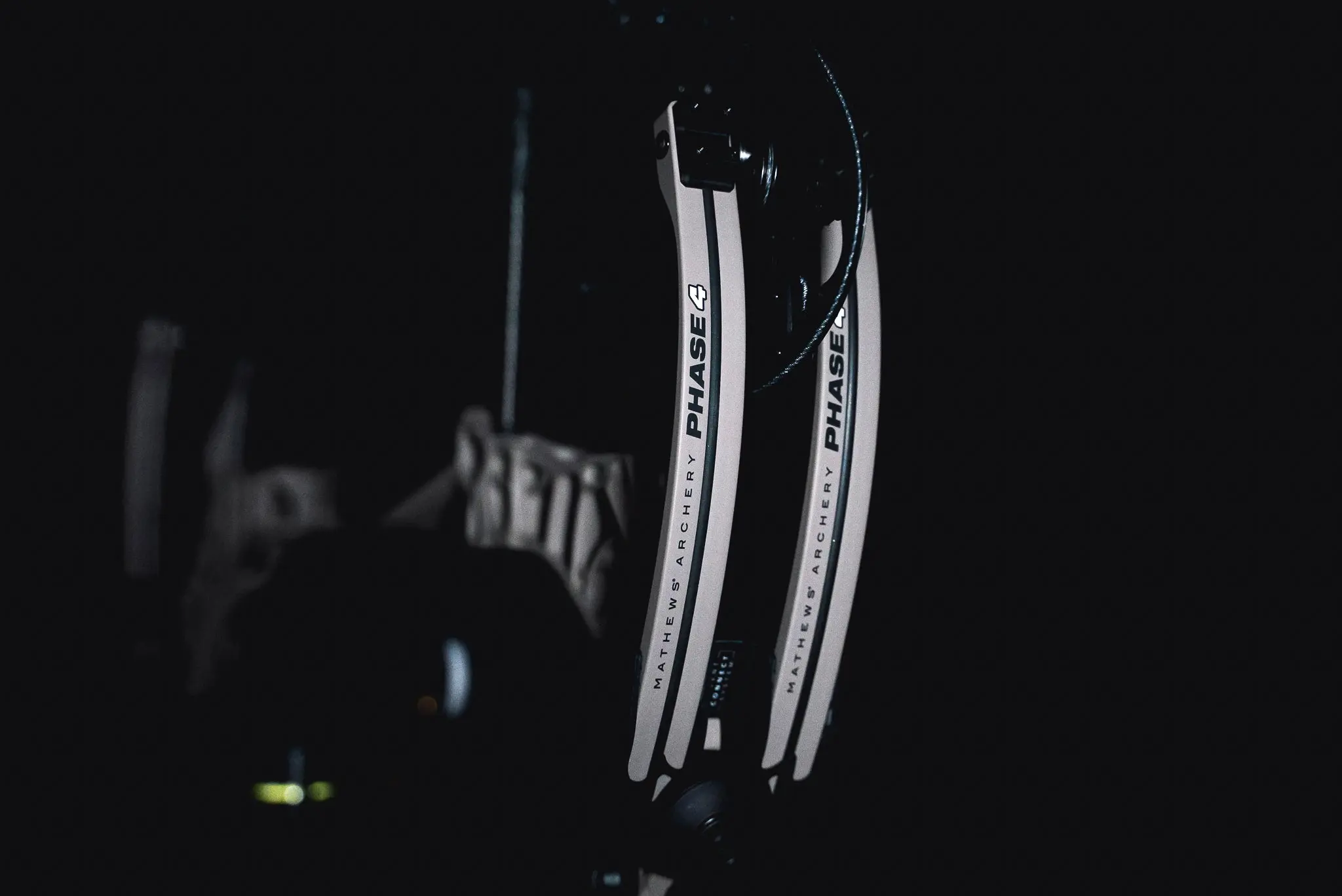
| Forrest Binkley |
The Phase 4 was very quiet and smooth shooting—but it wasn’t the winner in either of those categories this year. The Hoyt is a bit quieter, and it, the Elite, and the Bowtech all had less vibration, according to Stress Engineering data. The Phase 4 is fast; it tied with the Elite Omnia as this year’s speed champion, and it did that with a more manageable draw cycle. Our average group size with the Phase 4 was 1.05 inches, tied with the Hoyt for second-most accurate.
If you ask me, the accessory packages and hunt-friendly features such as the Stay Afield System (S.A.S.) are what really sets the new Mathews flagships apart. The S.A.S. is essentially a half-ounce bow press that can be carried into the field for fixing a peep sight or servicing the string and cables. New for 2023 is the Bridge-Lock Stabilizer that ports directly into the riser. Carryover accessories from last year include LoPro quivers and the Bridge-Lock sight, and the riser is dovetailed for a QAD Integrate rest, all of which make for an exceptionally low-profile hunting package.
Best Value Flagship Bow: Elite Omnia
Best Value Flagship Bow
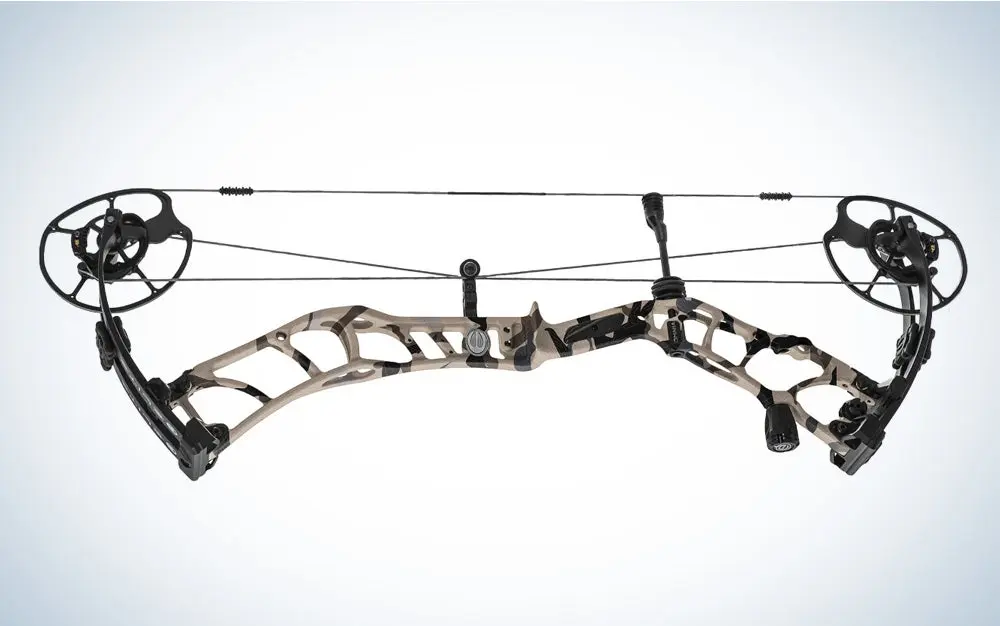
Specs
Axle-to-Axle Length: 32″
Brace Height: 6″
Weight: 5 lb., 11 oz.
Price: $1,199
Testing Results
Speed: 318 fps
Final Score: 92
Elite has submitted many of the smoothest bows we’ve tested over the past decade. “Shootability” is, in fact, the brand’s tagline. But they’re capable of building a high-performance speed bow, too,and this year’s Omnia proves it, tying with the Mathews Phase 4 as the fastest bow of the test. Like all recent Elite flagships, the Omnia features the brand’s Simplified Exact Tuning (S.E.T.) system, which we believe is the user-friendliest DIY tuning system on the market. With it, users adjust cam lean with a few turns of a bolt that flexes either side of the bow’s split limbs.

| Forrest Binkley |
The Omnia has a beefy, caged riser similar to last year’s EnVision, but it’s slightly longer and more reflexed. It also has a shorter brace height and the new SP Cam for better performance. The cams feature the V2 Micro Mod system that allows users to fine-tune draw length in ¼-inch increments, as well as adjust the feel of the back wall and valley. The Omnia also has the VersaMod system for adjusting the let-off in single percentiles from 70 to 90 percent. Though some assume that fast bows vibrate the most and are the loudest as a rule, the Omnia proved (as many previous models have ) that this “rule” is a load of marketing b.s. It was one of just three bows tested (the Hoyt and Bowtech being the other two) to achieve perfect, 10-point scores in both the lack of noise and lack of vibration categories.
Our range testing with the Omnia was a mixed bag. I shot it extremely well, but Hinton struggled with it, and Meador’s groups with it were middle of the pack. That put the bow’s overall accuracy average squarely in the middle. It had the most demanding draw cycle of anything tested this year, with an abrupt drop into the valley. You can tweak some of that to your liking, though, given the adjustably of the SP Cam system.
The Omnia’s grip put the bow hand a little too close to the cables, causing interference at times, depending on your grip style. Those flaws, though minor, cost it a few precious points. The Omnia is a fast, quiet shooter with a wide range of adjustability. None of today’s top bows are inexpensive, but the Omnia is the most affordable among our top 5 finishers, which earns it our Best Value Award for 2023’s crop of flagship bows.
Prime Revex 2
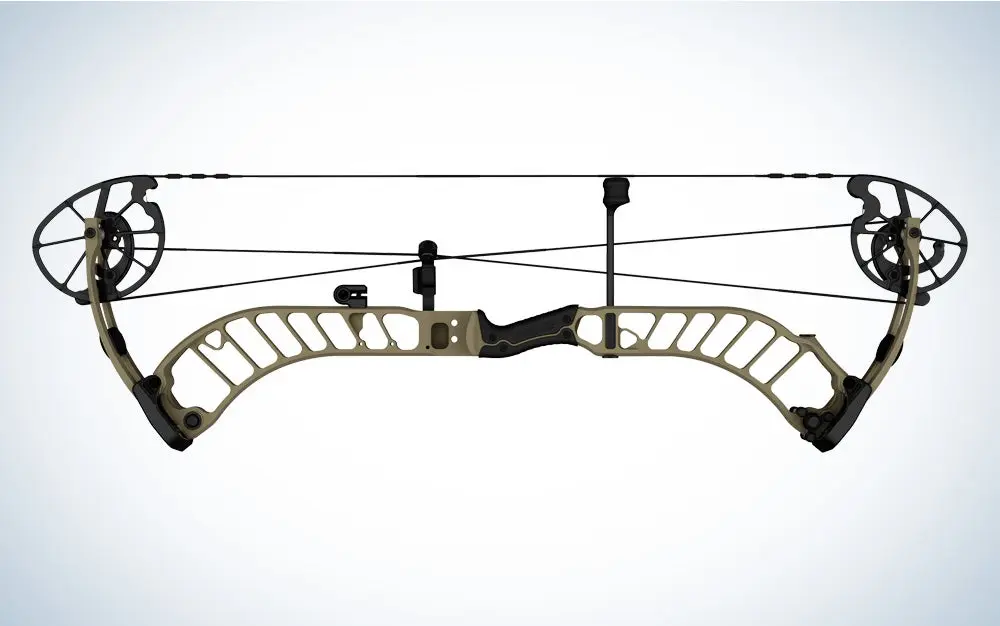
Specs
Axle-to-Axle Length: 32”
Brace Height: 6.25″
Weight: 5 lb., 9 oz.
Price: $1,199
Testing Results
Speed: 305 fps
Final Score: 92
Prime’s Inline cam system caught our attention during last year’s bow test as one of the more innovative designs we’ve seen in a while, and the most radical change to Prime’s signature parallel cams to happen in years. The cam module of the Inline system shifted the cables to underneath the cam at full draw to balance it. The new Core Cam on this year’s Revex line has the same technology, but it’s an improved system yet over the Inline. The Core Cam is a fixed draw-length system, so shooters will need to order the length that fits them properly.
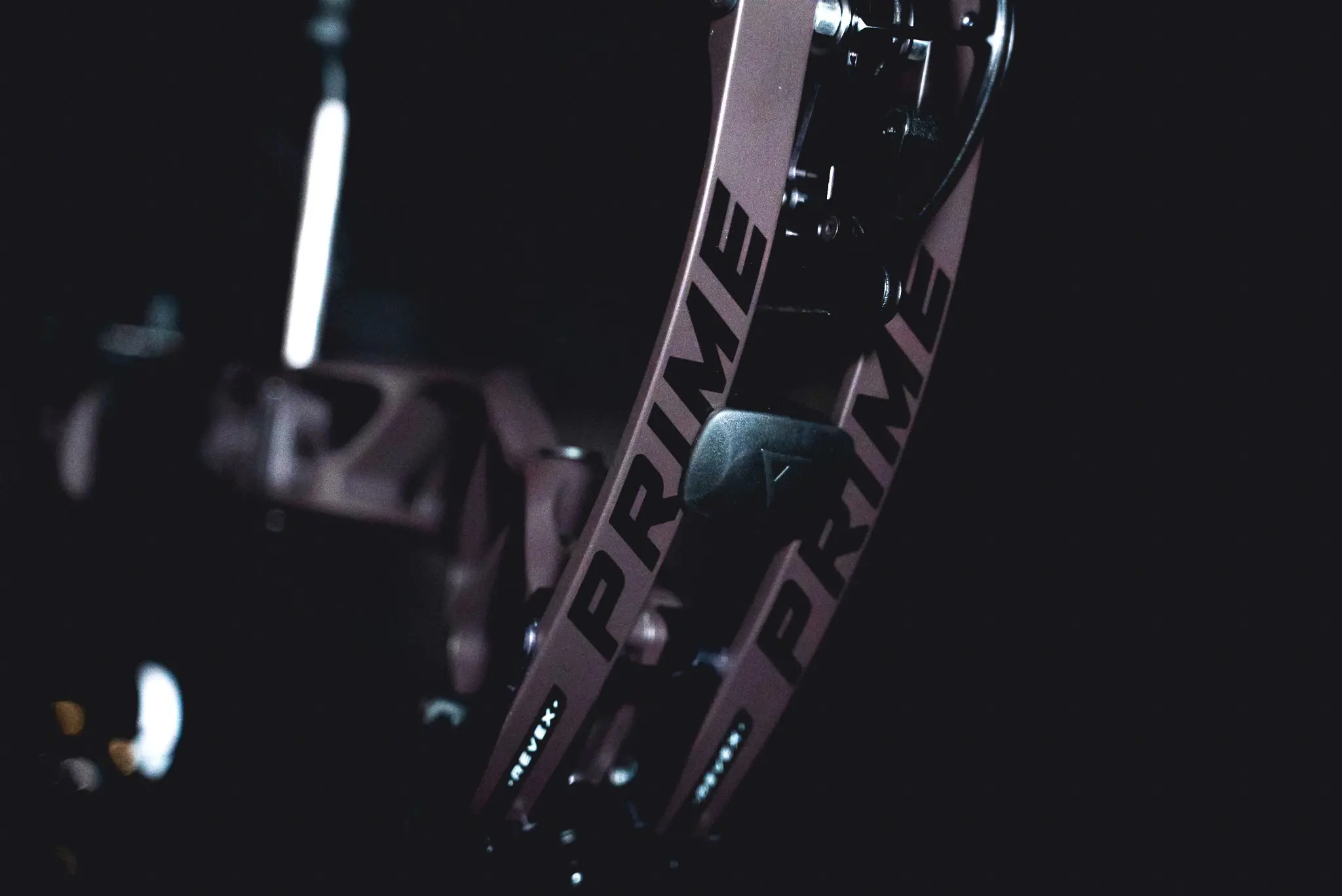
| Forrest Binkley |
We tested the 32-inch Revex 2 (34- and 36-inch models are also available), and it was one of the handier bows of the field this year. That size, combined with the Nanogrip that we all loved, made it one of the best-handling bows of the test. It had a good draw cycle, too, that was a touch more demanding than the competition, but that also settled into a nice valley with a solid back wall. That extra effort need to draw the bow gave some extra oomph, though, as the Revex was among the fastest bows in this year’s field. Testing at Stress proved that the Revex 2 was quiet with little vibration, though not at the very top of those categories.
We all shot this bow well enough, though, again, it wasn’t top of the pack for accuracy—and in a lineup this tight, those small point losses caused it to slip just out of the group of top finishers for 2023’s best compound bows. Like several other models tested this year, the Revex is specially designed to accept streamlined accessories such as a riser-mounted Tightspot quiver and a Hamskea limb-driven arrow rest, which should only complement what is already a trim, handy hunting package. Like the Elite, the Revex 2 is one of the most affordable flashships of 2023.
PSE Mach 34

Specs
Axle-to-Axle Length: 34″
Brace Height: 6.75″
Weight: 4 lb., 11 oz.
Price: $1,799
Testing Results
Speed: 301.6 fps
Final Score: 89
Initial impressions of PSE’s carbon bow were very good. That it’s more than a 1/2-pound lighter than the next-lightest bow in the field (and almost a 1-1/2 pounds lighter than the heaviest) made it fun to handle. It also had a great draw cycle; smooth throughout, with a solid back wall and comfortable valley. The average speed for all bows in this test was 304.5 fps, and so this bow was fast enough, if not blistering.
The Mach 34 is two-cam design featuring PSE’s Full Draw Stability system, which is designed to offset induced torque at full draw. Its draw-length adjustable by way of a mod, and various cam setups are available to accommodate a wide range of draw lengths. The Mach 34 also features the new EZ.220 spacer system for easily making cam-lean adjustments in a press. The riser has ports for a machined dovetail plate that can be used for mounting rests like the QAD Integrate.

| Forrest Binkley |
On the range, the Mach 34 did indeed seem to hold well on the target; Hinton and Meador both left remarks to that effect in their notes. But the bow lost ground in other categories. The grip dug painfully into my hand after a few groups, and there wasn’t a good way for me to adjust around that. Despite being easy to hold on target, none of us shot the Mach 34 very well; it was, in fact, the least accurate bow, on average, of the test.
The Mach 34 was quiet, but we all did notice a jump upon release, as the bow had more noticeable post-shot vibration than anything else we tested. It’s worth noting that we don’t weight that category heavily. Being “dead-in-the-hand” is a selling point for some bow companies, but as Meador put it, “I don’t care how much hand shock a bow has because the arrow is already on its way.” Still, it was more noticeable in the Mach 34 than anything else we tested, and Stress Engineering measurements verified this assessment.
Gearhead Pivot 30
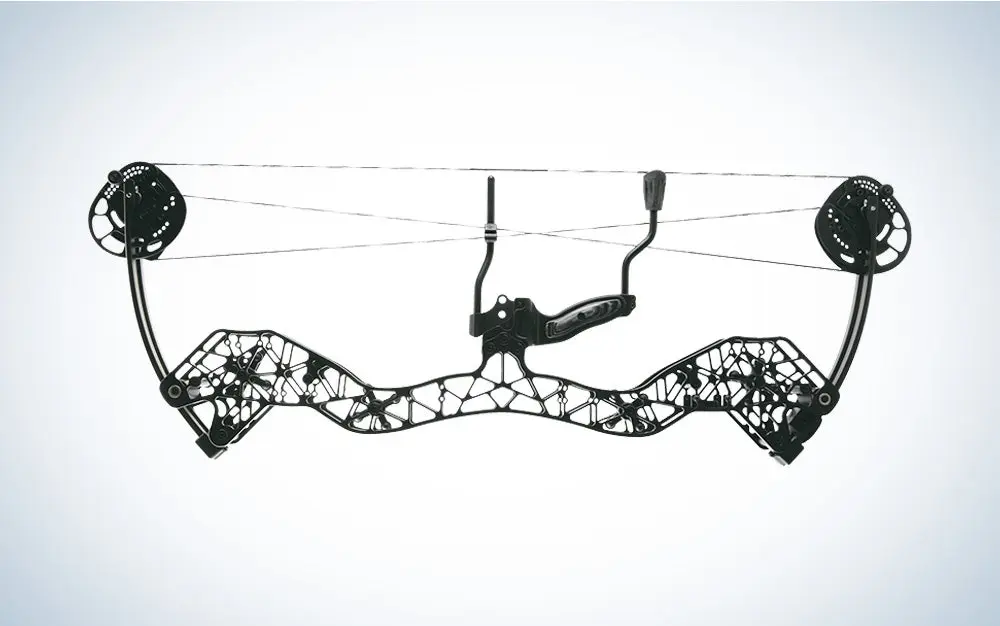
Specs
Axle-to-Axle Length: 30″
Brace Height: 6″ (adjustable)
Weight: 5 lb., 7 oz.
Price: $1,049
Testing Results
Speed: 299 fps
Final Score: 81
The Gearhead’s radically unique design makes it difficult to compare, in some ways, to the rest of the bows in this lineup. That we weren’t able to thread the accelerometer into the usual stabilizer port position is just one example. But that is by design, as the Pivot (P) 30 has versatile features that other bows don’t have, including an optional Slider grip that allows shooters to adjust the brace height, shoot left- or right-handed, or adjust left to right to offset torque. The let-off is adjustable, too, up to 90 percent, as is the draw length. The bow is compatible with a number of Gearhead accessories, including a bracket that allows users to mount stabilizers or an action camera between the bow’s risers.

| Forrest Binkley |
Hinton and I have previously shot Gearhead bows and knew what to expect—different, but well-built and accurate. Meador, who’d never seen one, picked up the P30 and said, “I don’t think I’m gonna like this thing.” But he proceeded to shoot .67-inch average-sized groups with it, making it his second-best shooting bow of the test. Stress Engineering data proved that the P30 was quiet and relatively free of vibration, too.
Still, the bow had a rough draw cycle compared to the competition, and despite being compact, we found handling it to be a hassle, especially the feed-through riser design. The string stop can interfere with the grip positioning of your bow hand, and Hinton and I found that the grip design itself made the bow difficult to hold on target. All of that, combined with sluggish speed, caused the P30 to fall to the bottom compared to the competition. But we all agreed, it’s a cool bow that fun to shoot and has advantages others don’t.
FAQs
What is the perfect bow size?
The best bow size is different for each person and depends on a few factors. First, you’ll have to find the ideal draw length for your height and physical size. Then, you’ll have to consider the draw weight based on your strength. The best way to find the right bow size is to get fitted at a local archery shop or outfitter.
Are bigger bows better?
Bigger bows aren’t necessarily better—but they might be better for some people, depending on your preferences. Bows with a longer axle-to-axle length tend to be more stable and slightly more accurate. However, shorter bows are typically more lightweight and easier to maneuver and handle.
Why Trust Us
For more than 125 years, Field & Stream has been providing readers with honest and authentic coverage of outdoor gear. Our writers and editors eat, sleep, and breathe the outdoors, and that passion comes through in our product reviews. You can count on F&S to keep you up to date on the best new gear. And when we write about a product—whether it’s a bass lure or a backpack—we cover the good and the bad, so you know exactly what to expect before you decide to make a purchase.
![Field & Stream [dev]](https://images.ctfassets.net/fbkgl98xrr9f/1GnddAVcyeew2hQvUmrFpw/e4ca91baa53a1ecd66f76b1ef472932b/mob-logo.svg)





